Basil is a versatile herb that has long been a culinary staple. Its sweet, aromatic leaves are used in a variety of cuisines, including pesto and pasta sauces, as well as salads and soups. Even if you’re new to gardening, cultivating basil on your garden bed is quite simple.
In this guide we’ll go through everything you need to know to grow a healthy basil plant, from selecting the correct location and soil to planting, watering, and harvesting your basil. Whether you’re an experienced gardener or a novice, keep reading to learn how to cultivate this vital herb and add fragrant and delicious taste to your foods.
A Brief History
Basil has a long and varied history, dating back thousands of years.
It is believed to have originated in India, where it was used as a medicinal herb. From there, it spread to other parts of Asia and eventually Europe.
In addition to its culinary uses, basil has also been used for religious and spiritual purposes for centuries. It was used as an offering to gods in ancient Greece and Rome, and it is still an important herb in many religions today.
In more recent times, basil has become a popular ingredient in many cuisines around the world. Its distinctive taste and aroma make it a key ingredient in Italian dishes like pesto and bruschetta. It is also popular in Asian dishes such as Thai curries and Vietnamese spring rolls.
Basil is easy to grow in most climates, making it a great option for home gardeners looking to add flavor to their dishes. With the right care and attention, you can enjoy fresh basil all year round!
Nutritional Benefits
Basil has many nutritional benefits that make it a great addition to your garden.
Rich in vitamins and minerals, as well as other phytonutrients, basil is a good source of vitamin K, vitamin A, magnesium, iron, and calcium. Vitamin K is important for blood clotting and maintaining healthy bones. Vitamin A helps maintain healthy vision, skin, and immune system. Magnesium helps regulate muscle and nerve function as well as blood sugar levels. Iron is necessary for red blood cell production. Calcium is essential for strong bones and teeth.
In addition to its vitamins and minerals, basil also contains powerful antioxidants that have been linked to a variety of health benefits. These antioxidants help protect the body from the damage caused by free radicals, which can lead to inflammation, certain types of cancer, and other diseases.
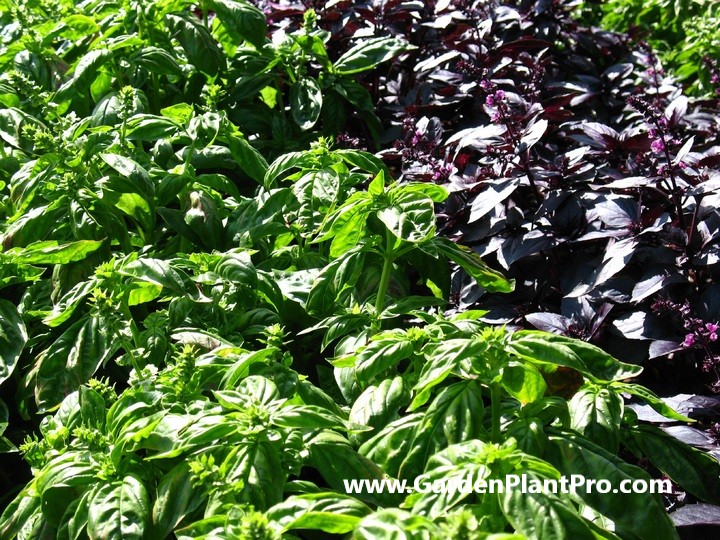
Common Varieties & Their Uses
When it comes to growing basil, there are many varieties to choose from.
Each variety offers different flavors and aromas, making them ideal for a range of recipes. Genovese basil is the most popular type of basil, and is widely used in Italian cuisine. It has an intense flavor with a hint of cloves and mint.
Thai basil is popular in Asian cuisine and has a sweet licorice flavor with a hint of spice. It also has a strong aroma that makes it an excellent choice for adding to salads or soups.
Lemon basil has a lemony flavor and fragrance, making it a great addition to citrus-based dishes like dressings or sauces.
Other varieties include cinnamon basil, which has a spicy cinnamon flavor; purple basil, which has a mild flavor but is often used as an ornamental plant; and holy basil, which is used medicinally in Ayurvedic medicine.
No matter which variety you choose, be sure to plant it in well-drained soil and in full sun for best results. Water regularly and fertilize during the growing season to ensure your plants get the nutrients they need to thrive.
When To Sow
Basil is a warm-season plant that grows well in hot, sunny weather.
If you wish to grow basil from seeds, start them indoors or in a glasshouse around 6-8 weeks before your area’s last frost date. This will give your basil seedlings an early start and guarantee that they are ready for transplanting into your garden bed as the weather warms up.
Alternatively you can sow them directly into your garden bed outside, after the soil temperature has reached at least 70°F (21°C) and the threat of frosts has passed. If you live in a colder region or just want to get a head start on the growing season, start your basil seeds inside or in a glasshouse.
It is important to keep the soil damp but not wet while spreading basil seeds. Cover the seeds with a thin layer of dirt and place them in a sunny spot. Basil seeds typically germinate in 5-10 days, and once sprouted, you may relocate them to a brighter spot or supply artificial light.
DIY PROJECT: Collect rainwater no matter where you live...
This DIY project is the best way to legally collect rainwater NO MATTER where you live. Get chlorine-free water, cut down on your water bills, and have enough for an emergency situation or to water your garden. Read More Here...
The ideal time to seed basil is entirely dependent on your local climate and the circumstances in your garden bed. Its best to plan ahead of time and sow your basil seeds inside or in a glasshouse before the final frost in your region, of course, you may also buy basil seedlings from a garden centre and put them into your garden bed as the weather warms up.
With many varieties available offering a variation of flavours, it is well worth making a space in your garden bed for at least one type of basil. With some patience and care, you can have your own fresh herbs at home all year round.
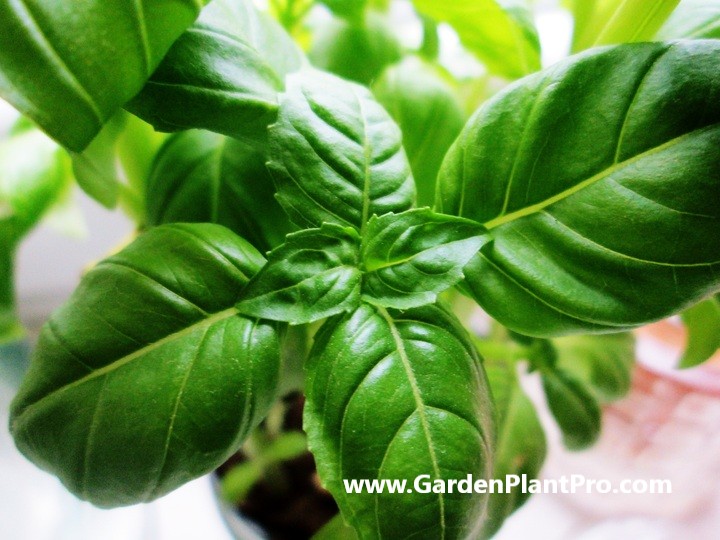
Choose The Right Location
Choosing the right location for your basil is essential to ensure a successful harvest.
When selecting a spot in your garden, look for a sunny, sheltered area that gets at least 6 hours of full sun each day. The soil should be well-draining, and it should have a pH between 6.5 and 7.
Raised beds can help with drainage and can give some protection from wind or other elements. Make sure the bed or pot is at least 8 inches deep to accommodate strong root growth. Plant your basil 12 to 16 inches apart for adequate sunlight and air circulation.
Basil will thrive in warm temperatures, so try to pick a spot that does not get too cold during the night or in the winter months. Once you have chosen the perfect location for your basil, you can start preparing the soil and planting your seeds or seedlings.
Prepare The Soil
Preparing the soil is one of the most important steps when growing basil.
The soil should be well-draining, moist, and moderately fertile. Adding plenty of organic matter to the soil helps create a nutrient-rich foundation for the plants to thrive. A neutral pH of 6.5 to 7.0 is ideal for basil growth. To check the pH of your soil, you can use a soil testing kit or take a sample to your local agricultural extension office.
If you’re planting in containers, make sure to use a potting mix specifically designed for container plantings and add a slow-release organic fertilizer into the mix. If planting in raised beds or in-ground gardens, scratch a slow-release organic fertilizer into the soil before planting. This will offer a steady source of nutrients throughout the growing season.
Once the soil is prepared, it’s time to plant your basil seeds or seedlings. Planting two weeks after the last spring frost will give your plants a chance to become established before summer heat sets in. Basil can be grown in raised garden beds, containers, or in-ground gardens; just make sure there’s enough space between plants so they can thrive without overcrowding.
Plant The Seeds Or Seedlings
Planting basil seeds or seedlings is a great way to grow a lot of plants for your garden. If you’re planting from seed, you can sow continuously from spring to summer for a continuous crop. Seeds should be sown one-half inch deep, with three seeds per seed-starting cell. Germination takes 5 to 14 days and then the plants can be potted on into individual pots when they are big enough.
When you’re ready to plant in the ground, make sure to choose the right location and prepare the soil first. Work in generous amounts of compost, as this will help ensure basil’s success.
Plant the seedlings or seeds at the same depth as they were in their original containers and water regularly. Fertilizing with an all-purpose fertilizer will also help your basil thrive. Additionally, it is important to make sure that your basil plants are spaced 12 to 16 inches apart to allow plenty of sunlight and air circulation around them.
Harvesting basil should be done regularly to keep the plants healthy. Choose the stems that have grown several sets of leaves and trim off those that have gone to seed or have started flowering. Preserving basil is easy, either by drying it or freezing it in cubes of water or oil.
Basil is prone to pests and diseases such as aphids, whiteflies and downy mildew, so keep an eye out for any signs of infestations or infections and take action if necessary. Finally, Basil is a great companion plant for many vegetables and herbs, so consider pairing it with other plants in your garden bed for even better results.
Water Regularly
Watering your basil regularly is essential for a bumper crop of fresh leaves. Before you water, stick a finger in the soil to gauge its moisture level. Basil likes to stay moist and requires approximately 1 inch of water every week.
Water deeply at least once a week to keep roots growing deep and strong. In the garden, basil plants likely only need water every 3 to 4 days. Containers need to be watered more frequently as the soil dries out faster in these conditions. Ensure you are providing your basil plants with a consistent supply of moisture, as this will help avoid the plant going to seed sooner than expected.
Do you have some charcoal in your house right now? We call charcoal a “miracle leftover” for anyone who wants to be a little more self-sufficient and cut costs. That’s because it can help you with so many different things around the house and garden. You can even use it to make an energy-free fridge. Read More Here...
When it comes to watering your basil, it’s important to understand the basics of your gardening environment and climate. If you have heavy clay soils, they tend to hold more moisture than sandy soils, so you may not need to water as often.
If you live in an area with a hot climate or windy conditions, you may need to water more frequently as these weather conditions can cause the soil to dry out faster. Be aware of rain events in your area too, as this can reduce the amount of watering needed for your basil plants.
When you do water your basil plants, be sure to use a gentle stream or sprayer so that you don’t disturb the soil too much or damage any other plants around it. Water slowly allowing the water to sink down into the soil and reach the plant’s roots. To check if your basil needs watering again, check both the surface and 1–2 inches down into the soil using your finger or a trowel. If it feels dry at either level then it’s time for another drink!
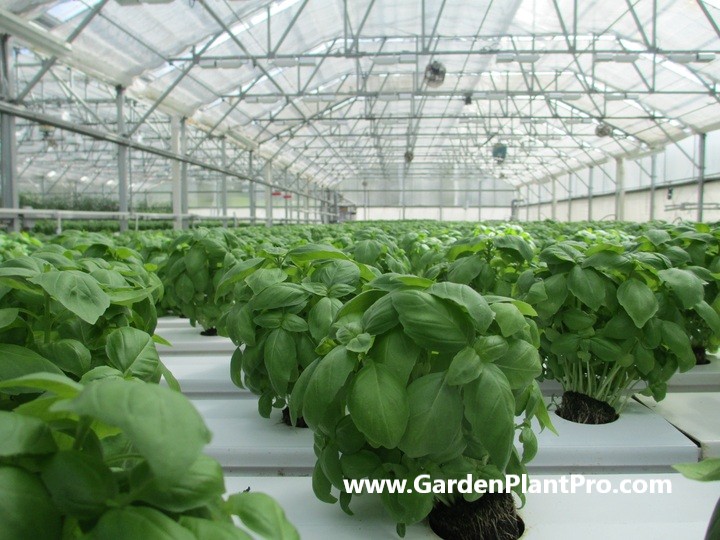
Fertilize
Fertilizing your basil is an important step in growing a healthy plant.
Once you have planted your basil seedlings or seeds, you should scratch a slow-release organic fertilizer into the soil. This will provide a steady feed all season long. For indoor plants, use a balanced, liquid fertilizer twice per month. For outdoor plants, a general all-round fertilizer should be applied one month after planting and then every four to six weeks for optimal growth.
When fertilizing, it is important to keep in mind the pH of the soil. The soil should be at least 8 inches deep for strong root growth and the pH should be moderately fertile and moist but well-draining. Adding compost or aged manure can help ensure optimal nutrition and fertility of the soil.
Finally, water your basil consistently and pick regularly to help avoid it going to seed. This will also ensure that your basil plants are getting enough nutrients from the fertilizer and will help them stay healthy and strong all season long.
Harvesting Basil
Harvesting basil is a rewarding part of growing this aromatic herb.
It’s best to begin harvesting once the plants have reached a height of 6 to 8 inches and have unfurled at least four sets of leaves. To harvest, pinch the leaves from the stems with your fingers. Don’t just pluck off the leaves – pinching encourages new growth and gives you more chances to harvest throughout the season.
Basil can be harvested in small amounts throughout the growing season, which will encourage bushier plants with more leaves. You can also harvest larger amounts all at once if needed. It’s best to harvest in the morning after dew has dried, but before the heat of the day has set in. If you’re not going to use it right away, basil should be stored in a cool, dry place.
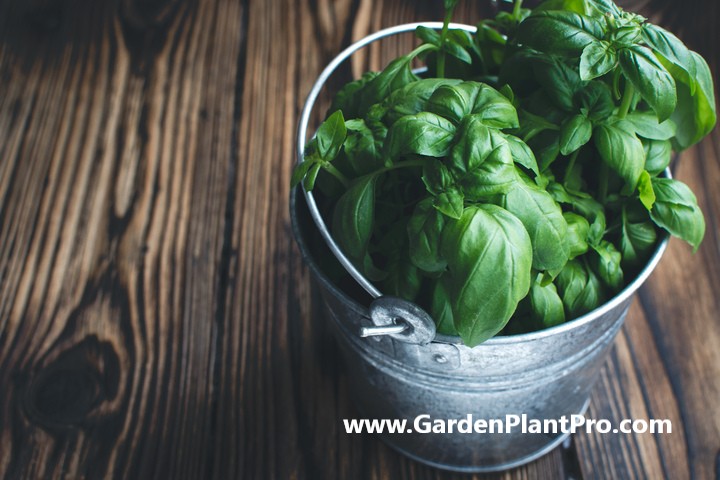
Preserving Basil
Preserving Basil is a great way to extend the life of your homegrown herb and enjoy its flavor in a variety of dishes. There are several methods that can be used to store basil, including refrigeration, freezing, and drying.
Refrigeration: For short-term storage or use within a few days of harvesting, refrigerating basil is a great option. To do this, simply rinse the leaves with cold water, pat them dry with a clean cloth or paper towel, and store them in an airtight container lined with a damp paper towel or cloth.
Freezing: If you want to enjoy your basil for months at a time, freezing is the way to go. To freeze basil, wash the leaves thoroughly and pat them dry. Place them in an airtight container or freezer bag and store in the freezer for up to 6 months.
Drying: Drying is another great method for preserving basil. To dry basil leaves, rinse them off with cold water and pat them dry with a clean cloth or paper towel. Place the leaves on a baking sheet lined with parchment paper and place in an oven preheated to its lowest setting (or around 100-110°F). Dry the leaves until they are crisp and brittle then remove from oven and allow to cool before storing in an airtight container.
No matter which method you choose to use for preserving your homegrown basil, it’s important to remember that these herbs will last longer when stored away from direct sunlight and heat sources such as ovens or hot surfaces.
Common Diseases & How To Control Them
Basil is vulnerable to several common diseases, and proper prevention and control measures are necessary to maintain a healthy, thriving plant. Fungal diseases such as powdery mildew, root rot, and fusarium wilt can all affect basil.
Powdery Mildew:
This fungus is most active in cool, damp conditions and can cause yellowing of the leaves, stunted growth, and a white powdery coating on the plant’s surface. To prevent powdery mildew from occurring, water your plants at their base rather than from above. Water in the morning so that they have time to dry off during the day.
CASE STUDY: We've been living off the grid for the last 40 years...
In all that time an electric wire has never been connected to our house. We haven’t gotten or paid an electricity bill in over 40 years, but we have all the electricity we want. We grow everything we need, here, in our small backyard. We also have a small medicinal garden for tough times. Read More Here...
Root Rot:
Root rot is caused by a soil-borne fungus that attaches itself to the roots of the basil plant and causes them to become brown and mushy. To prevent root rot, make sure your soil has good drainage. Planting in raised beds improves drainage and helps protect against root rot.
Fusarium Wilt:
This fungus blocks water flow within the plant and can cause wilting of the leaves, discoloration on stems, and eventual death of the plant if not treated. To reduce the risk of fusarium wilt, wait until all danger of frost has passed before planting outside and harden off plants gradually to acclimatize them to outdoor conditions.
If you notice any signs of disease on your basil plants, it’s important to act quickly. Dig up affected plants to inspect for any signs of infection or damage caused by pests or fungi. Remove affected parts of the plant and dispose of them away from other plants.
If you’re unable to save an affected plant, make sure you sterilize any tools that have come in contact with it before using them on other plants. For more severe cases, applying a fungicide may be necessary.
Common Pests & How To Control Them
Basil plants may suffer from a variety of pests, including aphids, whiteflies, and spider mites.
To control these pests, start by cleaning up your garden bed. Remove weeds and debris that may be harboring insects. You can also use natural predators such as ladybugs and lacewings to help keep pest populations down.
If you find that you have a problem with aphids, whiteflies, or spider mites, spray the affected area with a solution of water and 1 teaspoon of mild dish soap. You can also use neem oil or insecticidal soap to help control the pests. Apply the spray directly to the affected leaves and stems until the solution is dripping off. Repeat as needed until the pests are under control.
If you have a severe infestation, you may need to use chemical insecticides such as carbaryl or pyrethrin. Always follow the instructions on the label when using chemical products.
You can also use companion planting to help deter pests from your basil plants. Planting companion plants such as garlic, onions, and marigolds near basil can help repel some insects. Planting basil near tomatoes can also be beneficial since tomatoes produce an odor that deters some pests from attacking basil plants.
Finally, if you spot any pests on your basil plants, you can remove them by hand picking them off the leaves and stems. This is an effective way of controlling small infestations before they become too severe.
Companion Planting
Companion planting is a great way to maximize the health of your basil plants.
By planting basil with other crops that benefit from each other, you can create an ecosystem where pests and diseases are kept to a minimum. Basil is known to repel some pests, and it can also improve the flavor of neighboring crops.
When selecting companion plants for basil, it’s important to consider how they will interact with one another. Generally, it’s best to choose plants that have similar growing conditions and requirements. For example, root vegetables like radishes, parsnips, carrots, beets, and turnips are all good companion plants for basil. These vegetables all benefit from the pest-repelling qualities of basil.
Asparagus, borage, chamomile, oregano, chives and marigolds are also ideal companion plants for basil. Marigolds naturally repel many common garden pests and when planted near basil, can improve its flavor as well. Other herbs like cilantro and parsley also make great companion plants for basil as they can provide it with additional nutrients and help to promote healthy growth.
It’s important to keep in mind that companion planting doesn’t guarantee pest or disease protection. However, it is an effective way to minimize their presence and improve the health of your plants in the long run. By creating a diverse ecosystem in your garden bed with a variety of beneficial companion plants, you can ensure that your basil has all the resources it needs to thrive.
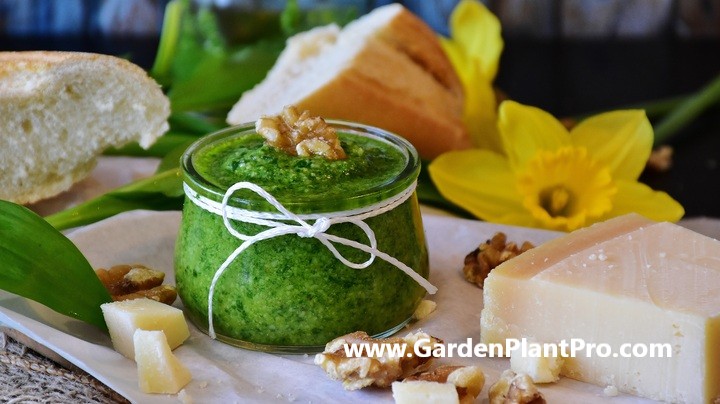
Using Basil In Your Cooking
Once the basil plants are ready for harvest, they can be used in a variety of dishes.
Cooking with fresh basil can add a bright, zesty flavor to any meal.
Basil is incredibly versatile and can be used in both savory and sweet dishes. It can be added to salads, cooked with vegetables, mixed into dressings and sauces, or used as a garnish. Basil can even be added to desserts such as ice cream and baked goods for a fragrant touch.
When incorporating basil into a dish, it is best to add it towards the end of the cooking process in order to preserve its flavor and aroma. To get the most flavor from fresh basil, it should be added just before serving. Dried or frozen basil should also be added at the end of the cooking process.
When harvesting basil from the garden or store-bought herbs, it is important to remove any wilted or discolored leaves before use. Fresh basil can also be stored in an airtight container in the refrigerator for several days before use.
Basil can also be preserved by freezing, drying or making pesto. To make pesto, combine equal parts olive oil and fresh basil leaves in a blender or food processor with garlic and pine nuts (or another nut of your choice). Blend until combined and season with salt and pepper to taste. Pesto stored in an airtight container in the freezer will last up to three months.
Whether cooking with fresh or preserved basil, adding this fragrant herb can transform any dish into something special. So get creative and enjoy all that this versatile herb has to offer.




